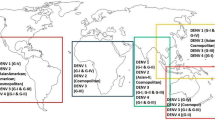Abstract
In recent years, patients affected by dengue fever are getting increased. Outbreaks of dengue fever can be prevented by taking measures in the initial stages. In countries with high disease incidence, it requires early diagnosis of dengue. In order to develop a model for predicting, outbreak mechanism should be clarified and appropriate precautions must be taken. Increase in temperature, sea surface temperature, rapid urbanization and increase of rainfall due to global warming is the interplay factors which influences the outbreaks. Human travel and displacement due to increase in urbanization and temperature, causes dengue virus-infected mosquitoes to be spread. High accurate classification can be achieved by deep learning methods. It is a versatile and regressive method. Small amount of tuning is required by this and highly interpretable outputs are produced. Healthy subjects and dengue patients are differentiated by the factors determined by this and they are used to visualize them also. These factors increase the stability and accuracy of the boosting process in construction of dengue disease survivability prediction model. Problems in overfitting can also be reduced. Applications like decision support systems in healthcare, tailored health communication and risk management are incorporated with the proposed method.
Access this chapter
Tax calculation will be finalised at checkout
Purchases are for personal use only
Similar content being viewed by others
References
Carvalho et al., Host genetics and dengue fever. Infect. Gen. Evol. (2017)
V. Nandini, R. Sriranjitha, T.P. Yazhini, Dengue detection and prediction system using data mining with frequency analysis. Comput. Sci. Inf. Technol. (CS & IT) (2016)
P. Siriyasatien, A. Phumee, P. Ongruk, K. Jampachaisri, K. Kesorn, Analysis of significant factors for dengue fever incidence prediction. BMC Bioinf. (2016)
T.-C. Chan, T.-H. Hu, J.-S. Hwang, Daily forecast of dengue fever incidents for urban villages in a city. Int. J. Health Geograph. (2015)
N.K. Kameswara Rao, G.P. SaradhiVarma, M. Nagabhushana Rao, Classification rules using decision tree for dengue disease. Int. J. Res. Comput. Commun. Technol. 3(3) (2014)
A.L.V. Gomes, L.J.K. Wee, A.M. Khan, et al., Classification of dengue fever patients based on gene expression data using support vector machines. PLoS One 5(6), Article ID e11267 (2010)
P. Guo, T. Liu, Q. Zhang, et al., Developing a dengue forecast model using machine learning: a case study in China. PLoS Neglect. Trop. Dis. 11(10), Article ID e0005973 (2017)
T.M. Carvajal, K.M. Viacrusis, L.F.T. Hernandez, H.T. Ho, D.M. Amalin, K. Watanabe, Machine learning methods reveal the temporal pattern of dengue incidence using meteorological factors in Metropolitan Manila, Philippines. BMC Infect. Dis. 18(1), 183 (2018)
A. ShameemFathima, D. Manimeglai, Analysis of significant factors for dengue infection prognosis using the random forest classifier. Int. J. Adv. Comput. Sci. Appl. (IJACSA) 6(2) (2015)
M.I.H. Khan, et al., Factors predicting severe dengue in patients with dengue fever. Mediterr. J. Hematol. Infect. Dis. 5(1) (2013)
J.A. Potts et al., Prediction of dengue disease severity among pediatric Thai patients using early clinical laboratory indicators. PLoS Negl. Trop. Dis. 4(8), e769 (2010)
W. Caicedo-Torres, A. Paternina, H. Pinz´on, Machine learning models for early dengue severity prediction, in M. Montes-y-G´omez, H.J. Escalante, A. Segura, J.D. Murillo (eds.), IBERAMIA 2016. LNCS (LNAI), vol. 10022 (Springer, Cham, 2016), pp. 247–258
V.J. Lee et al., Simple clinical and laboratory predictors of chikungunya versus dengue infections in adults. PLoS Negl. Trop. Dis. 6(9), e1786 (2012)
K. Laoprasopwattana, L. Kaewjungwad, R. Jarumanokul, A. Geater, Differential diagnosis of chikungunya, dengue viral infection and other acute febrile illnesses in children. Pediatr. Infect. Disease J. 31(5) (2012)
A. Paternina-Caicedo, et al., Features of dengue and chikungunya infections of Colombian children under 24 months of age admitted to the emergency department. J. Trop. Pediatr. (2017)
Keogh, Mueen, Curse of dimensionality, in Encyclopedia of Machine Learning (Springer, 2011), pp. 257–258
V.O. Andersson, M.A.F. Birck, R.M. Araujo, Towards predicting dengue fever rates using convolutional neural networks and street-level images, in 2018 International Joint Conference on Neural Networks (IJCNN) (IEEE, 2018), pp. 1–8
Y. LeCun, Y. Bengio, G. Hinton, Deep learning. Nature 521(7553), 436–444 (2015)
R.G.J. Wijnhoven, P.H.N. de With, Fast training of object detection using stochastic gradient descent, in Proceedings of International Conference on Pattern Recognition (ICPR) (Tsukuba, Japan, 2010), pp. 424–427
Consent
The consent of the data was obtained from the participants/patients was verbal.
Author information
Authors and Affiliations
Corresponding author
Editor information
Editors and Affiliations
Rights and permissions
Copyright information
© 2021 Springer Nature Singapore Pte Ltd.
About this paper
Cite this paper
Shukla, A., Goyal, V. (2021). Deep Learning-Based Severe Dengue Prognosis Using Human Genome Data with Novel Feature Selection Method. In: Bhatia, S.K., Tiwari, S., Ruidan, S., Trivedi, M.C., Mishra, K.K. (eds) Advances in Computer, Communication and Computational Sciences. Advances in Intelligent Systems and Computing, vol 1158. Springer, Singapore. https://doi.org/10.1007/978-981-15-4409-5_43
Download citation
DOI: https://doi.org/10.1007/978-981-15-4409-5_43
Published:
Publisher Name: Springer, Singapore
Print ISBN: 978-981-15-4408-8
Online ISBN: 978-981-15-4409-5
eBook Packages: Intelligent Technologies and RoboticsIntelligent Technologies and Robotics (R0)




